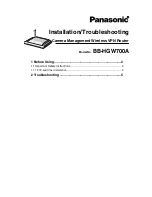
Administrative Tool
p. 99
MaxConnections
The maximum number of connections that can
be requested or are acceptable. The result func-
tion is Min.
MaxRecvDataSegmentLenght
The maximum amount of data that the target
can receive in any iSCSI PDU. This is a connec-
tion- and direction- specific parameter. The
actual value used for targets will be Min (This
value, MaxBurstLength) for data-in and solicited
data-out data. Min (This value, FirstBurstLength)
for unsolicited data.
MaxXmitDataSegmentLenght
The maximum amount of data that the target
can transmit in any iSCSI PDU. This is a con-
nection- and direction- specific parameter. The
actual value used for targets will be Min (This
value, MaxBurstLength) for data-in and solicited
data-out data. Min (This value, FirstBurstLength)
for unsolicited data.
MaxBurstLenghth
Maximum SCSI data payload in bytes for data-in
or for a solicited data-out sequence. The respon-
der’s number is used. The result function is Min.
FirstBurstLength
Maximum SCSI payload, in bytes, of unsolicited
data an initiator may send to the target. Includes
immediate data and a sequence of unsolicited
Data-Out PDUs. Must be <= MaxBurstLength.
The result function is Min.
DefaultTime2Wait
Min seconds to wait before attempting connec-
tion and task allegiance reinstatement after a
connection termination or a connection reset.
The results function is Max. A value of zero
means that task reassignment can be done im-
mediately. Also known as Time2Wait.
DefaultTime 2Retain
Max seconds that connection and task allegi-
ance reinstatement is still possible following
a connection termination or reset. The results
function is Min. Zero means no reinstatement is
possible. Also known as Time2Retain.
Summary of Contents for G-RACK 12
Page 1: ......
Page 2: ...Copyrights...
Page 4: ...Introduction...
Page 9: ...Getting Started...
Page 12: ...Getting Started p 12 Front View Rear View...
Page 32: ...Administrative Tool...
Page 48: ...Administrative Tool p 48 Extended information from smartctl utility...
Page 92: ...Administrative Tool p 92 Comment Optional comment text box...
Page 109: ...Administrative Tool p 109 Example error message...
Page 124: ...Administrative Tool p 124 Memory usage Network interfaces...
Page 130: ...Hardware Description...
Page 159: ...Use Cases Tutorials...
Page 180: ...Use Cases Tutorials p 180...
Page 184: ...Use Cases Tutorials p 184 You need to click the enable slider to activate this option...
Page 191: ...Use Cases Tutorials p 191 Lastly a review is presented before the shares are created...
Page 192: ...Use Cases Tutorials p 192 Once you confirm the process starts...
Page 215: ...Use Cases Tutorials p 215 6 The RAID is ready...
Page 221: ...iSCSI Essentials...
Page 228: ...iSCSI Essentials p 228 Links and references https en wikipedia org wiki ISCSI...
Page 234: ...Troubleshooting...
Page 247: ...F A Q...
Page 272: ...Technical Support Warranty...
Page 283: ...Glossary...
Page 289: ...Appendices...
















































